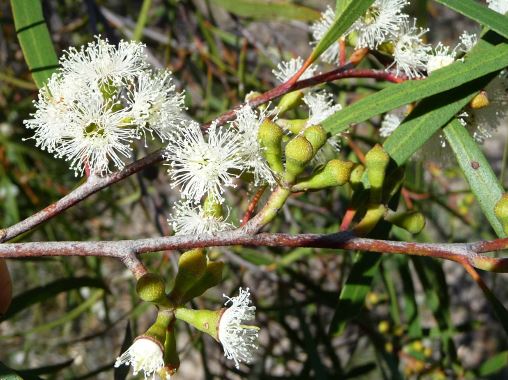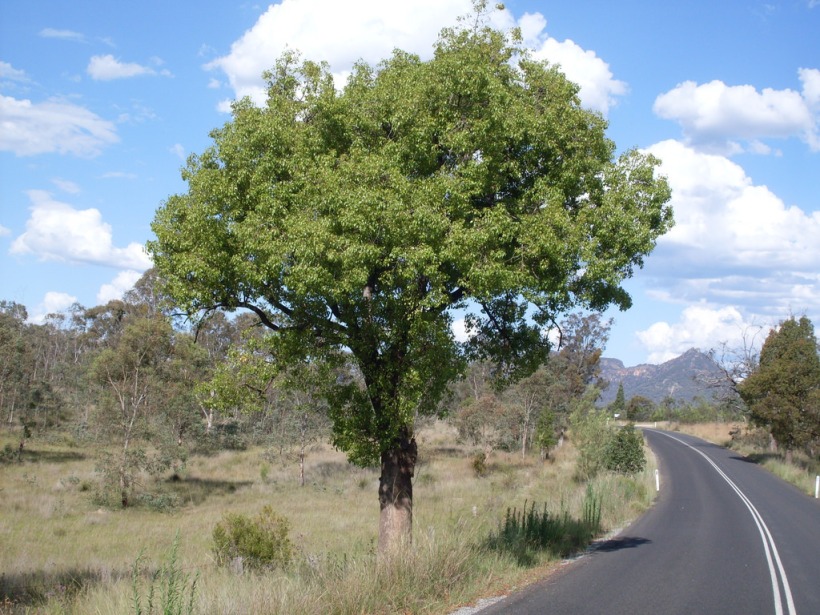“Is that Eucalyptus tereticornis?” – Me
“It’s hard to tell, they can hybridise” – Said by someone more experienced.
Just as I was getting used to the idea of identifying Eucalypt species by their shape of gumnut (fruit) and bark type, thrown into the barrel now is the fact that they can hybridise!!!
So how is it possible for Eucalypt species to hybridise? It is said for two species to hybridise, there first needs to be genetic compatibility. In technical terms this means both species must have the same numbers of chromosomes (genetic material). Additional factors that come into play is if the two separate species have similar (synchronous) flowering times and pollen vectors. Separate species that hybrid where one flowers outside the flowering times of the other is only created through human manipulation.
So what species in NSW hybridise?
After some research from various sources online, just some of the many hybrids that occur in NSW include Eucalyptus apiculata (E. burgessiana × E. stricta), Eucalyptus saligna × botryoides, and Eucalyptus patentinervis (E. robusta × E. tereticornis). There may also be hybridisations that have not been fully recorded, including Stringybark species.
Can you tell if a tree is a hybridised species?
This is a tricky question to answer. In most cases hybrids will confuse the person trying to ID them as they might appear intermediate in some features such as bark type or crown colour between the two parent species (EUCLID 2017), show features of both parents (e.g. E. botryoides and E. saligna situated in NSW, DEE 2017), show features of only one parent species (e.g. E. annuliformis endemic to Western Australia, EUCLID 2017) or not show any characteristic features of either parent species (e.g. E. drummondii native to southwest Western Australia, EUCLID 2017).
Let’s use this exercise to compare parent species and their characteristic feature to three well documented hybrid Eucalypt species.
Eucalyptus apiculata
E. apiculata is described as both rare and localised between Linden and Berrima of NSW typically found in mallee (multi-trunk) shrublands on sandy soils on ridge tops or escarpment landscapes (PlantNET). E. apiculata (leaves up to 0.7 cm wide) has linear leaves which can be distinguished from E. stricta (~ 1.6 cm wide) which has narrow-lanceolate leaves and also distinguished from E. burgessiana (leaves up to 2.5 cm wide) which has lanceolate leaves.
Comparing the fruits of parent species shows that E. apiculata resembles both E. burgessiana and E. stricta. E. stricta has globose, ovoid or urceolate shaped fruits (7-10 mm in diameter) while E. burgessiana has globose or urceolate shaped fruits (8-12 mm diam.). EUCLID (2017) describes E. apiculata fruits as pedicellate, cup-shaped, urceolate shaped fruits (6-10 mm diam.).
For further in depth comparsion, we recommend reading EUCLID webpage on Ecualyptus apiculata which can be found at: https://www.anbg.gov.au/cpbr/cd-keys/Euclid/sample/html/APICUL.htm

Image by Warren Sheather, from APS – Armidale website.
Eucalyptus saligna × botryoides
E. saligna × botryoides, commonly known as Wollongong Woollybutt or Southern Blue Gum, is found on the south coast of NSW in the Illawara region, south of Sydney. This species is known to resemble its parent species, E. saligna based on physical attributes such as appearance and type of bark. For example E. saligna is known to be a part bark species of Eucalypt with a short fibrous stocking at the base versus E. botryoides known as a full bark species of Eucalypt with rough, red stained bark extending to all limbs of its branches. E. saligna × botryoides is also a part bark species of Eucalypt with grey smooth bark above its stocking, “sock” like E. saligna. Attributes that resemble E. botryoides includes shape of leaf, buds and fruits. More in-depth comparison can be seen in the positioning of stomata on the leaves.
For more information on E. saligna × botryoides, see Wollongong’s Native Trees at: http://www.nationalregisterofbigtrees.com.au/listing/770.pdf
Eucalyptus patentinervis
E. patentinervis, commonly known as Bastard Mahogany is known to occur where stands of both parent species are within close proximity to each other, particular transition zones. This union is particularly strange when E. tereticornis is known to occur in Cumberland Plain areas in grassy wooded alluvial flats where E. robusta tend to occur in Sandstone areas in floodplain forests. Comparison of bark types is also interesting to note. E. tereticornis has a smooth bark and E. robusta is a full bark species of Eucalypt. E. patentinervis is highly variable and has different attributes depending on location, geology and climate. Some stands of E. patentinervis are fully rough barked, while other have been recorded containing part bark with smooth branches. Consistency seems to be present in the shape of its fruits, leaves and colour of flowers.
Other descriptions of this species include white to pink flowers, flattened flower stems and venation of the leaves more closely resemble E. tereticornis. For images of E. patentinervis, see Northern Beaches Herbarium Gallery at:
http://northernbeachesherbarium.com.au/gallery3/index.php/Trees/Eucalypts-bark-rough/Eucalyptus-robusta-x-tereticornis?page=2
Other species that E. robusta has been recorded hybridising with other species of Eucalypt include bangalay (E. botryoides), flooded gum (E. grandis), Tasmanian blue gum (E. globulus), woollybutt (E. longifolia) and Bancroft’s red gum (E. bancroftii).
Conclusion
All in all hybrids are quite unquie specimens and have unique origins to where, when and how they came into existence. Eucalypt hybrids continue to studied for progeny tests confirming their origin. Today hybrids are a debateable topic to whether they should be classed as a subspecies, a variety of a species, or its own independent species.
To see a full classification of the Eucalypts species (including Angophoras, Corymbia and Eucalyptus), see Nicolle D (2015) Classification of the Eucalypts (Angophora, Corymbia and Eucalyptus), Version 2, available online at: http://www.dn.com.au/Classification-Of-The-Eucalypts.pdf
Sources
Department of Environmental and Energy, 2017. National Vegetation Information System Taxonomic Review: 3.0 Results. Available online at: http://www.environment.gov.au/node/18958 [Accessed 08 August 2017].
EUCLID 2017, Learn about eucalypts, Available online at: https://www.anbg.gov.au/cpbr/cd-keys/euclid3/euclidsample/html/learn.htm [Accessed 08 August 2017].
EUCLID 2017, Eucalyptus apiculata, Available online at: https://www.anbg.gov.au/cpbr/cd-keys/Euclid/sample/html/APICUL.htm [Accessed 08 August 2017].
Gallery 2017. Eucalyptus robusta x tereticornis hybrid – Bastard Mahogany or E patentinervis , Northern Beaches Herbarium. Available online at: http://northernbeachesherbarium.com.au/gallery3/index.php/Trees/Eucalypts-bark-rough/Eucalyptus-robusta-x-tereticornis [Accessed 08 August 2017].
Lopez G, A., Potts B, M., and Tilyard P, A., 2000, ‘F1 hybrid inviability in Eucalyptus: the case of E. ovata × E. globulus’, Heredity, vol. 85, pg. 242–250. Available online at: https://www.nature.com/hdy/journal/v85/n3/full/6887390a.html [Accessed 08 August 2017].
National Register of Big Trees, 2017, Eucalyptus saligna × E. botryoides, Wollongong’s Native Trees, Available online at: http://www.nationalregisterofbigtrees.com.au/listing/770.pdf [Accessed 08 August 2017].
PlantNET – FloraOnline 2017. Eucalyptus apiculata R.T.Baker & H.G.Sm. Available online at: http://plantnet.rbgsyd.nsw.gov.au/cgi-bin/NSWfl.pl?page=nswfl&lvl=sp&name=Eucalyptus~apiculata [Accessed 08 August 2017].
PlantNET – FloraOnline 2017. Eucalyptus saligna Sm. Available online at: http://plantnet.rbgsyd.nsw.gov.au/cgi-bin/NSWfl.pl?page=nswfl&lvl=sp&name=Eucalyptus~saligna [Accessed 08 August 2017].
PlantNET – FloraOnline 2017. Eucalyptus tereticornis Sm. Available online at: http://plantnet.rbgsyd.nsw.gov.au/cgi-bin/NSWfl.pl?page=nswfl&lvl=sp&name=Eucalyptus~tereticornis [Accessed 08 August 2017].
PlantNET – FloraOnline 2017. Eucalyptus robusta Sm. Available online at: http://plantnet.rbgsyd.nsw.gov.au/cgi-bin/NSWfl.pl?page=nswfl&lvl=sp&name=Eucalyptus~robusta [Accessed 08 August 2017].
















